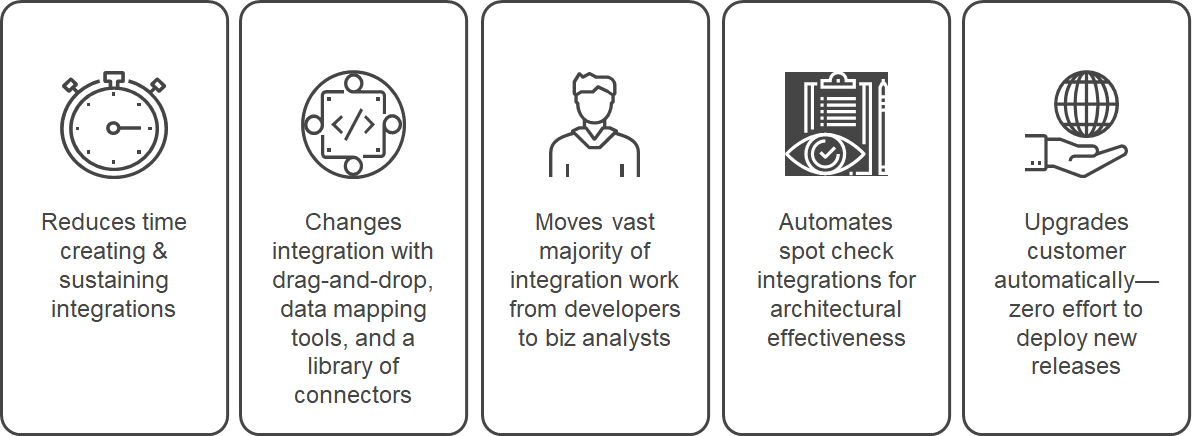We all loved the movie “Shrek,” especially the line where Shrek says to Donkey, “Ogres are like onions, we have layers.” Many of the largest businesses are like onions too, even though layering is not a good architectural or technology decision for achieving faster application and data integration.
Our CIO friends affectionately call these application and data integrations layers “duct tape and Band-Aids.” But this legacy-style separation of application and data integration into two distinct user experiences holds businesses back from achieving their digital transformation initiatives.
A Time to Delayer and Reimagine
So, I am sorry, Shrek. It is time to de-layer that IT onion and reimagine how businesses connect their applications and data. It is time to ask hard questions. Why do we have separate platforms to connect cloud applications and on-premises applications? Why do we use EAI and ESBs in some places and hand-coding in others? And why is cloud different from everything else? After all, computing workloads after COVID-19 have moved between on-premises, private clouds and external cloud providers. Notice that I used “providers” versus “provider.” This was purposeful.
And why do we have separate platforms for connecting our applications and data? Clearly, data flows at different rates depending upon the customer use cases, but can’t we have a single platform that supports all styles of integration regardless of the business intent for the data which is being connected? Frankly, organizations need one platform that does it all. They need one solution! This solution should handle all speeds of integration and require no additional learning between integration styles.
How Should We Think About This?

This above chart shows the range of use cases organizations might need their integration solution to support. On the left-hand side are use cases about moving data between source and target systems. These are the BI use cases. Here, data transfers depending upon application take place in near-real-time, or nightly. The amount of data transfer is typically larger and done in a batch form.
Meanwhile, the real-time examples on the right reflect a variety of data and integration use cases. Each has different data rate requirement. Some, for example, process large amounts of streaming data at the edge and then aggregate this data for later transfer and analysis. Think of data being created from a continuous manufacturing process, or the data streamed out of a set of medical devices connected to a patient. Or think of applications that need to be constantly in synch regarding data changes.
Historically, all of these styles of integration required separate software and approaches. And even worse, they required separate people, with separate skills, to manage them. According to “Enterprise Architecture as Strategy: Creating a Foundation for Business Execution,” companies that establish technology standards decrease the number of platforms that they manage. Fewer platforms mean lower costs.”1
This also means higher business agility if the skills are transferable between platform components. One of Boomi’s smaller customers has been able to have two people create and manage every component because there was knowledge transfer across all components.
As we stated earlier, there needs to be one platform that does it all — and in a recent discussion with a major systems integrator, they indicated that going forward they only want partners that can offer this type of comprehensive solution.
iPaaS: That Single Platform
It is now possible to converge everything onto one platform for application and data integration regardless of the speed of data transfer that your use cases may demand. That platform is integration platform as a service (iPaaS).
iPaaS takes advantage of drag-and-drop build processes and community to eliminate the work of integration or other data processes. This means that building and maintaining integrations costs a fraction of the dollars and takes a fraction of the effort. And these processes can live where the application or data workloads live.
The image below shows just a few of the advantages of de-layering with a single platform:

As well as reducing the time needed to create and maintain integrations, the iPaaS approach makes integrations easy enough so that a business analyst can build them without help from IT. And instead of the “install-and-done” of legacy software, iPaaS automatically checks the integrations for issues and maintains them for you. This means that businesses can invest their scarce development resources in other places.
Parting Words
I know it is hard, but it is time for organizations to declutter, de-layer, and move to one platform. This will save time, money, and maybe even your business. There isn’t time to maintain the old fashioned way.
At Boomi, we help you save both time and money by providing a unified solution that spans application and data integration. One user experience, giving you the ability to create integrated experiences for your employees and customers.
We provide this to you with the support of more than 15,000 customers, and a community of over 65 thousand collaborators. We have captured and curated their best-practice integrations into over 127 million crowdsourced mappings to guide your next integration. There’s no need to go it alone and figure out how to integrate applications and data from scratch.
We hope you’ll join the global integration team of Boomi users — all are welcome, no matter if you’re an application developer, an IT administrator, a business analyst, an enterprise architect…or even an ogre.
Experience for yourself why more than 15,000 customers around the world are using the Boomi Enterprise Platform. Try it out for free for 30 days!
—————————————————————————————————————————————————————-
- “Enterprise Architecture as Strategy: Creating a Foundation for Business Execution,” Jeanne W. Ross, Peter Weill, David C. Robertson (page 74)


 English
English 日本語
日本語